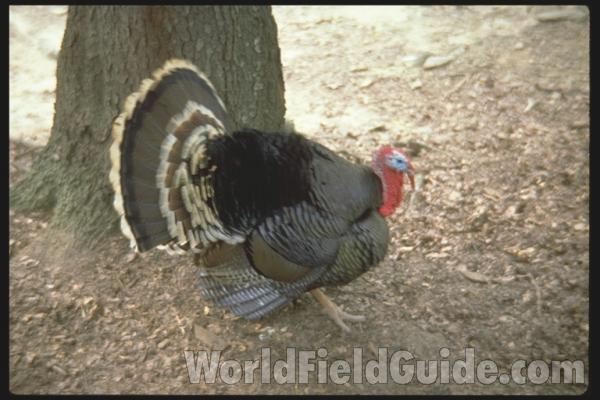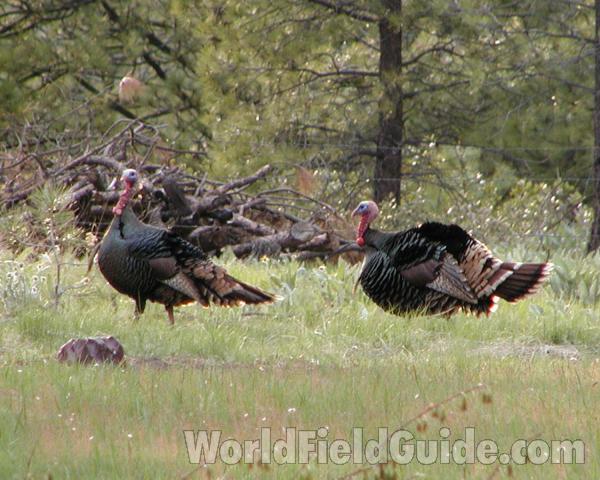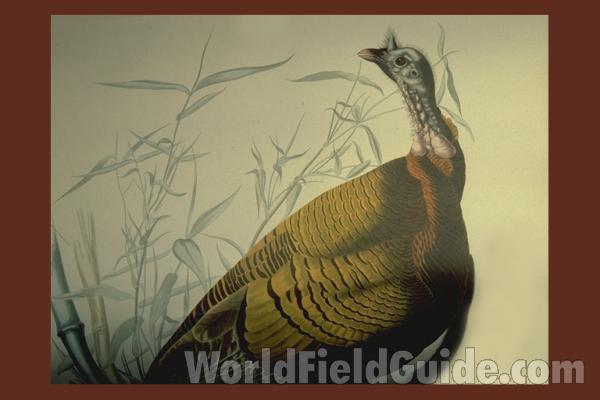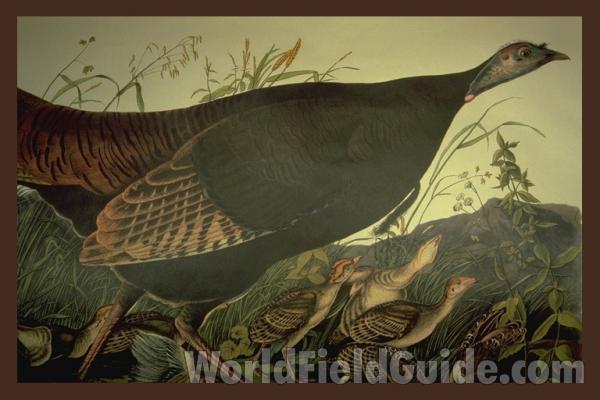SPECIES INFO
Wild Turkey (Meleagris gallopavo) is found in the eastern United States and in parts of the south and into Mexico. This is the species that provided food for the early pilgrim settlers and is tied to the Thanksgiving holiday in the United States.
During the early part of the twentieth century, from 1930 to l950, this species almost became extinct in the wild because of excessive hunting pressures. However, enormous efforts by state conservation groups have succeeded in reintroducing this wary species into the wild in numerous different places.
In the Howard and Moore checklist of 2003 there are 6 subspecies listed.
The nominate subspecies, Meleagris gallopavo gallopavo is found in west central Mexico. The subspecies silvestris found in the south eastern United States. The subspecies osceola is found in southern Florida. The subspecies intermedia is found from northern Texas south into north eastern Mexico. The subspecies mexicana is found in northwestern and north central Mexico. The subspecies merriami is found in the southwestern United States and south into northwestern Mexico.The North American turkey genus (Meleagris) contained a single 48 inch species found in both North America and south into northern and central Mexico. This was the status for many years and as recent as 1993 in the Monroe check list the Mexican (also found in Honduras and Guatemala) species was kept in a separate genus. However, in the Howard and Moore checklist of 2003, we note the addition of the 36 inch Mexican turkey species into the Meleagris genus. (Agriocharis ocellata to Meleagris ocellata).
Turkeys (Family Meleagridae) are a group contains only two species of New World fowl-like birds.
Fowl group (Galliformes order) contains the various chickens and turkey-like birds of the world. There are about 240 different species of fowl known. Many of the wild species are endangered. Several species such as the domesticated chicken and turkey are main food sources in the world. Most fowl are grain eaters and spend a good portion of their life searching for food on the ground. Select species have been domesticated for their beauty and/or edibility, others are considered good game birds.
Aves contains about 8,650 different species of living birds known to science. Each year about one new species is discovered in some remote rain forest or remote island. In addition, scientists have been raising many subspecies to full species status which may raise the species count to 10,000. Birdlife recognizes 10,027 species as of 2011.
However, each year about one species goes extinct. The rate of extinction is increasing, and the rate of new discovery is decreasing, so that the number of bird species will soon begin to decline rapidly. Although different taxonomists would organize the birds differently, there are approximately twenty-seven orders of birds. These orders are broken down into about one hundred and fifty-five different families.
Recent research of the genetic structure of some of the shore birds and owls would indicate that the present organization of orders and families should have some modification.
The birds are a worldwide group of animals that are characterized by having the front limbs modified into wings that are used for flying. Perhaps the most unique feature of the birds is the feathers. These feathers are made up of a central support called a quill and a series of small filaments that are hooked together as barbs.
For many years it was believed that Archaeopteryx discovered in Bavaria was the oldest bird from about 150 million years ago. However, in l986, Sankar Chattterjee, a Texas paleontologist, reportedly discovered a bird in the genus Protoavis that lived about 225 million years ago.
When this project was begun in 1978, we used Austin & Singer for bird taxonomy. Since then, we have adopted many changes, but have kept some older concepts that are still found widely in the literature. Recently, we have used Clements and Howard & Moore. Very recently, we have used Monroe and Sibley for the higher taxonomy of the perching birds.
Backboned Animals (Phylum Chordata) are the most advanced group of animals on earth. These animals are characterized by having a spinal cord or backbone. Most members have a clearly defined brain that controls the organism through a spinal cord. Fish, amphibians, reptiles, birds, and mammals are in this phylum.
Currently, some taxonomists believe that the fish should be divided into two groups (sharks and regular fishes) and that there are some other primitive groups in the phylum such as hagfish or lampreys.
Animal Kingdom contains numerous organisms that feed on other animals or plants. Included in the animal kingdom are the lower marine invertebrates such as sponges and corals, the jointed legged animals such as insects and spiders, and the backboned animals such as fish, amphibians, reptiles, birds, and mammals.









